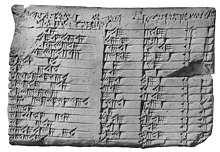
Back بليمبتون 322 Arabic Plimpton 322 Catalan پلیمپتۆن ٣٢٢ CKB Plimpton 322 German Plimpton 322 Spanish پلیمپتن ۳۲۲ Persian Plimpton 322 French פלימפטון 322 HE Plimpton 322 Italian プリンプトン322 Japanese
| Plimpton 322 | |
|---|---|
 The Plimpton 322 clay tablet, with numbers written in cuneiform script | |
| Height | 9 cm |
| Width | 13 cm |
| Created | c. 1800 BC |
| Present location | New York City, New York, United States |
Plimpton 322 is a Babylonian clay tablet, notable as containing an example of Babylonian mathematics. It has number 322 in the G.A. Plimpton Collection at Columbia University.[1] This tablet, believed to have been written around 1800 BC, has a table of four columns and 15 rows of numbers in the cuneiform script of the period.
This table lists two of the three numbers in what are now called Pythagorean triples, i.e., integers a, b, and c satisfying a2 + b2 = c2. From a modern perspective, a method for constructing such triples is a significant early achievement, known long before the Greek and Indian mathematicians discovered solutions to this problem.
There has been significant scholarly debate on the nature and purpose of the tablet. For readable popular treatments of this tablet see Robson (2002) recipient of the Lester R. Ford Award for expository excellence in mathematics or, more briefly, Conway & Guy (1996). Robson (2001) is a more detailed and technical discussion of the interpretation of the tablet's numbers, with an extensive bibliography.
- ^ "158. Cuneiform Tablet. Larsa (Tell Senkereh), Iraq, ca. 1820-1762 BCE. -- RBML, Plimpton Cuneiform 322", Jewels in Her Crown: Treasures of Columbia University Libraries Special Collections, Columbia University, 2004